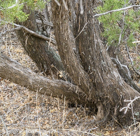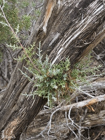Conservation Status

Juniperus pinchotii
Sudworth (1905)
Common names
Pinchot juniper, redberry juniper, táscate [Spanish], ekawaapi̠ [Comanche], wa'ap(ü) [Ute].
Taxonomic notes
Type: USA, Texas, "Palodura Canyon" (Palo Duro Canyon), G. L. Clothier s.n., 1903 (holotype US!). This species is in Section Sabina, within the clade of western hemisphere serrate-leaved junipers, within the subclade of one-seeded junipers (J. angosturana, J. arizonica, J. coahuilensis, J. monosperma, J. pinchotii), as supported by multiple lines of molecular evidence. The clade itself seems to have originated about 10-15 million years ago (Miocene) (Uckele et al. 2021).
Synonymy:
There are no infraspecific taxa, although some populations formerly assigned to J. pinchotii are now recognized as J. arizonica or J. coahuilensis. J. pinchotii and J. coahuilensis hybridize, but despite older reports to the contrary, J. pinchotii does not hybridize with J. ashei or J. monosperma (Adams 2014).
Description
Dioecious shrubs or small trees up to 6 m tall, usually multistemmed with stems to 20 cm diameter, having an irregular crown. Bark first smooth, then becoming flaky, then becoming fibrous, pale gray, exfoliating in strips. Twigs stiff, about 1 mm diameter, erect, 3-4-sided in cross section. Bears both needles-like and scale-like leaves, but the scale-like leaves predominate; they are yellow-green, 1-2 mm long, not overlapping or overlap only slightly, and have an acute apex; many bear ruptured glands that emit an aromatic white exudate. Seed cones maturing in 1 year, 6-8 mm diameter, copper to copper-red in color, juicy, sweet (not resinous), mostly with a single seed 4-5 mm in diameter (Adams 2008). See García Esteban et al. (2004) for a detailed characterization of the wood anatomy. See Adams (2013) for characterization of leaf essential oils.
Distribution and Ecology
US: New Mexico, Oklahoma, and Texas; Mexico: Coahuila and Nuevo León; at 300-1000(-1700) m elevation; on gravelly limestone and gypsum soils; on rolling hills and in ravines (Adams 1993, 2008). Hardy to Zone 7 (cold hardiness limit between -17.7°C and -12.2°C) (Bannister and Neuner 2001). See also Thompson et al. (1999).
Distribution of the primary serrate-leaf-margin Juniperus taxa of western North America; J. pinchotii shown in lavender. Adams (2014) would assert than nearly all trees shown as J. pinchotii in Mexico are in fact J. coahuilensis, but he does not provide sufficient detail to demarcate the two taxa. Click on any marker for more information and a link to the source.
Ueckert (1997a) asserts that "prior to development of the range livestock industry in western Texas, redberry juniper populations were primarily restricted to rocky outcrops and rocky, north-facing slopes where they were protected from intense grass fires." Since the late 19th century, the juniper has expanded into neighboring native grasslands due to reduced frequency and intensity of grass fires, along with overgrazing which reduced herbaceous cover and created opportunities for juniper seedling establishment. The juniper commonly occurs in association with honey mesquite (Neltuma glandulosa) or shrub live oak (Quercus turbinella), and is successional to it. The seeds can survive ground fire and the plants can resprout after cutting or fire (Sudworth 1905, Ueckert 1997a). Thus, frequent fire favors development of grassland, while fire suppression leads to development of juniper woodland (Hauser 2007 and numerous citations therein). Grazing pressure, by reducing competition from bunchgrasses, also favors juniper development (McPherson and Wright 1990).
Redberry juniper generally has low resistance to fire. Low to moderate intensity fires will kill seedlings
and saplings. Mature trees can resprout after a burn has killed the aboveground tissues, but commonly require 3-50 years to
attain pre-fire height (Hurteau 2006). Seedling establishment typically requires two years of above-average precipitation (Hurteau 2006).
This species provides wildlife forage and habitat. The berries are a food source for insects, birds, and varied mammals including rodents and canids (fox and coyote). Deer browse the young foliage readily, and it times of scarcity, may browse older foliage. The woodlands provide cover for ungulates and nesting habitat for birds (Hauser 2007).
Due to a very large area of occurrence and the existence of many robust populations, J. pinchotii is of "Least Concern" for conservation.
Remarkable Specimens
American Forests (1996) reported the "champion" was a tree in Alpine, Texas with diameter 115 cm, height 7 m, and crown spread 8 m. Ages to 175 years have been reported from isolated buttes in Garza County, Texas (Ellis and Schuster 1968, Mullins and Mitchell 1996), but as seen in the photo at right, substantially older trees likely occur.
Ethnobotany
The Kiowa, Comanche, Cheyenne, and Apache used J. pinchotii in the construction of bows and arrow shafts (Great Plains Flora Association 1986). The Comanche used it to treat headaches, vertigo, and "ghost sickness" [undefined]. For these ailments they would sprinkle dried leaves over hot coals and inhale the smoke. They also used an extract of the dried and pulverized roots to treat menstrual problems (Jones 1968).
There appears to be no current commercial use of this species. The wood is unsuitable for lumber and is not used for craftwood. It is not a viable source of cedarwood oil; of 12 U.S. junipers investigated by Adams (1987) for cedarwood oil production, J. pinchotii had the lowest levels, and by a wide margin. Unlike most species in the Cupressaceae, the wood is not rot-resistant (Adams 2008), and so is not suitable for the universal use of juniper in the American west: as fenceposts. On the contrary, because it readily invades overgrazed grasslands and readily resprouts after cutting, ranchers regard redberry juniper as a weed. There has been considerable research and effort devoted to redberry juniper control. Principal control methods in use include (Ueckert 1997b):
- Grazing management to maintain adequate grass cover to discourage juniper invasion.
- Prescribed fire to control juniper seedlings and saplings, repeated on an 8-10 year cycle.
- Control by goat grazing (Nelle 2001). Considerable effort has been devoted to the selective breeding of goats that will forage heavily on J. pinchotii. The traditional biocontrol approach, using insects, is unsuitable because of the high probability that insects would impair junipers in areas where they are desirable for wildlife habitat or that they would transfer to economically desirable juniper species.
- Mechanical methods. These include hand pulling, hand cutting, bulldozing, grubbing, root plowing, chaining, masticating, and hydraulic shears.
- Herbicides, such as picloram and hexazinon (Mullin 1998). These are especially effective on small plants.
- These methods may be more effective when used in combination, and the focus should always be on seedling and sapling control, as these are the most vulnerable life history stages.
However, Nelle (2001) notes that the ecological consequences of juniper control can be extensive, and often adverse, so he proposes a "holistic perspective" to be applied in control efforts:
- Juniper–oak woodlands are the native vegetation type on certain sites, and in those areas, juniper control is ecologically questionable.
- Juniper has encroached and increased where it was not a part of the native vegetation.
- Under overgrazing, juniper encroachment is a natural ecological response and provides a degree of protection to the site.
- Juniper encroachment is caused by fire suppression and by overgrazing, which prevents the accumulation of fine fuels.
- The increase of juniper to high densities causes significant problems for ranching.
- Encroaching juniper should only be considered after making a long term commitment to proper grazing management.
- Prescribed fire is a natural and highly effective control for small encroaching junipers.
- Goats control can be effective, but also has adverse effects on many desirable woody plants.
- Maintaining the native plant diversity at a site is benefits wildlife habitat, soil health, watershed function,
ecological stability, and economic viability.
The species is of limited scientific value. One dendrochronology study has evaluated stem diameter-age relationships (Mullin 1998).
Observations
The type locality for the species, Palo Duro Canyon in north Texas, is also a state park. Junipers of all ages can be seen there, in a wide variety of ecological settings. The area also supports J. ashei and J. monosperma, but J. pinchotii is far more abundant.
Remarks
The epithet honors Gifford Pinchot, who at the time was head of the Division of Forestry, but who later in 1905 became the first head of the U.S. Forest Service. Like J. pinchotii, he was intolerant of fire, and was disliked by ranchers.
Citations
Adams, Robert P. 1987. Investigation of Juniperus species of the United States for new sources of cedarwood oil. Economic Botany 41:48-54.
Adams, Robert P. 1993. Juniperus. Flora of North America Editorial Committee (eds.): Flora of North America North of Mexico, Vol. 2. Oxford University Press. This document is available online. Go to http://www.efloras.org, click on "Flora of North America," and search for "Juniperus."
Adams, Robert P. 2008. Junipers of the World: The Genus Juniperus. Second edition. Trafford Publishing. Brief versions of the descriptions are available online at Adam's website, www.juniperus.org.
Adams, Robert P. 2013. Chemosystematics of Juniperus: Effects of Leaf Drying on the Essential Oil Composition of Juniperus Pinchotii. Phytologia 95(1):10–17.
Adams, Robert P. 2014. Junipers of the World: The Genus Juniperus. Fourth edition. Trafford Publishing.
American Forests 1996. The 1996-1997 National Register of Big Trees. Washington, DC: American Forests.
Ellis, Dalton, and Joseph L. Schuster. 1968. Juniper age and distribution on an isolated butte in Garza County, Texas. The Southwestern Naturalist 13(3):343-348.
Great Plains Flora Association. 1986. Flora of the Great Plains. Lawrence, KS: University Press of Kansas. 1392 p.
Hauser, A. Scott. 2007. Juniperus pinchotii. In: Fire Effects Information System. U.S. Department of Agriculture, Forest Service, Rocky Mountain Research Station, Fire Sciences Laboratory. Available: http://www.fs.fed.us/database/feis/, accessed 2009.11.29.
Jones, D.E. 1968. Comanche plant medicine. Papers in Anthropology 9:1-13.
McPherson, G. R. and H. A. Wright. 1990. Effects of cattle grazing and Juniperus pinchotii canopy cover on herb cover and production in western Texas. American Midland Naturalist 123:144-151.
Mullins, Susan Jean. 1998. Management and ecology of redberry juniper in the Texas rolling plains. PhD dissertation, Texas Tech University.
Mullins, Susan J., and Robert B. Mitchell. 1996. Management and ecology of redberry juniper on the Texas Rolling Plains. P. 12 in C. M. Britton and D. B. Wester (eds.), Research highlights 1996: Noxious brush and weed control; range and wildlife management. Volume 27. Lubbock, TX: Texas Tech University, College of Agricultural Sciences and Natural Resources.
Nelle, Stephan A. 2001. Ecological implications of using goats for control of juniper in Texas. Pp. 352-355 in E. D. McArthur and D. J. Fairbanks (comps.), Shrubland ecosystem genetics and biodiversity: proceedings; 2000 June 13–15; Provo, UT. Proc. RMRS-P-21. Ogden, UT: U.S. Forest Service, Rocky Mountain Research Station.
Sudworth, G. B. 1905. A new species of juniper for Texas. Forestry & Irrigation 11:203-206. Available: Biodiversity Heritage Library, accessed 2024.12.01.
Ueckert, Darrell N. 1997a. Biology and ecology of redberry juniper. In Juniper Symposium. Texas A&M Research and Extension Center. Available: Texas Natural Resources Server, accessed 2024.12.01.
Ueckert, Darrell N. 1997b. Juniper control and management. In Juniper Symposium. Texas A&M Research and Extension Center. Available: Texas Natural Resources Server, accessed 2024.12.01.
Uckele, Kathryn A., Robert P. Adams, Andrea E. Schwarzbach, and Thomas L. Parchman. 2021. Genome-wide RAD sequencing resolves the evolutionary history of serrate leaf Juniperus and reveals discordance with chloroplast phylogeny. Molecular Phylogenetics and Evolution 156: 107022. https://doi.org/10.1016/j.ympev.2020.107022.
Yang, Yong, David Kay Ferguson, Bing Liu, Kang-Shan Mao, Lian-Ming Gao, Shou-Zhou Zhang, Tao Wan, Keith Rushforth, and Zhi-Xiang Zhang. 2022. Recent advances on phylogenomics of gymnosperms and a new classification. Plant Diversity 44(4):340-350.
See also
Farjon (2005) provides a detailed account, with illustrations.
Little (1980).
McPherson, G. R. and H. A. Wright. 1987. Factors affecting reproductive maturity of redberry juniper (Juniperus pinchotii). Forest Ecology and Management 21:191-196.
McPherson, G. R. and H. A. Wright. 1989. Direct effects of competition on individual Juniperus pinchotii plants: a field study. Journal of Applied Ecology 26:979-988.









